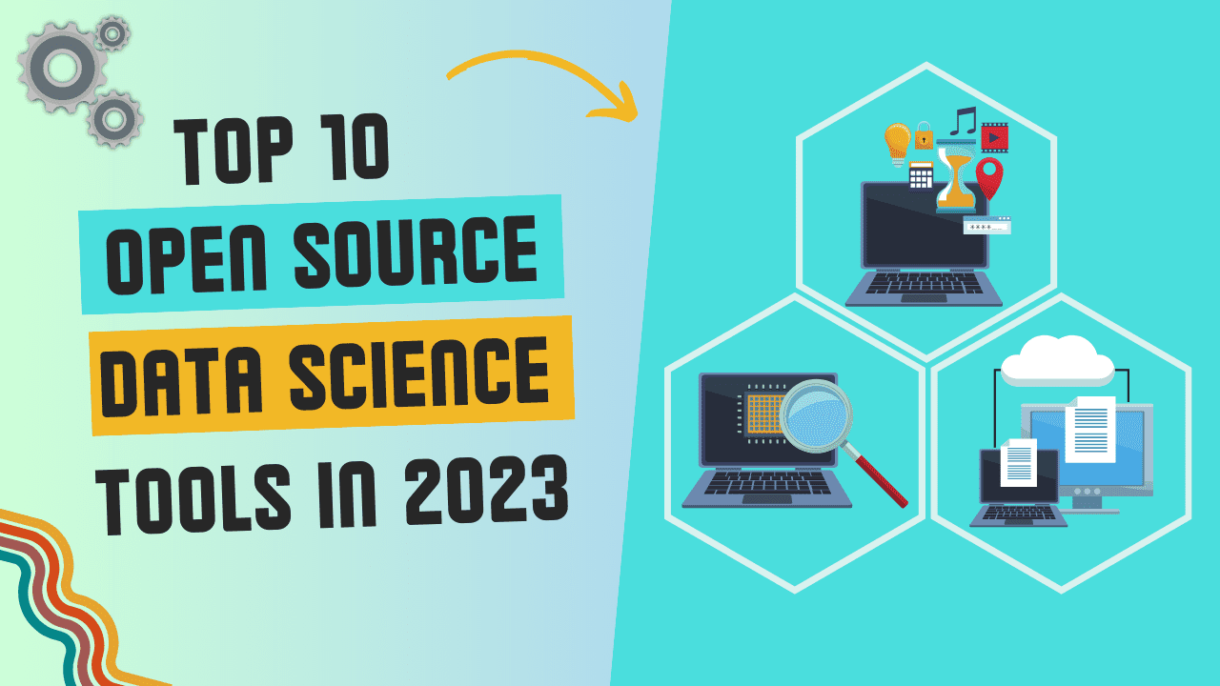A Glimpse into the 2023 Data Science Toolkit
In the age where data is revered as the corporate world’s new gold, data science has gained unprecedented prominence. Data scientists are akin to modern-day alchemists, tasked with the responsibility of transforming raw, unstructured data into insightful, actionable intelligence. However, the digital universe is expansive and navigating through the immense volume of data can be akin to searching for a pearl in the ocean’s depths. This is where the arsenal of data science tools becomes indispensable, offering the capabilities to extract, cleanse, organize, and interpret data effectively. Amidst the plethora of available tools, finding the ones that resonate with your specific needs can be daunting. This article, fortified with insights garnered from personal experimentation, community contributions, and industry trends, unveils ten open-source tools that are not just cost-effective but also renowned for their adaptability and transparency.
If you have any question, feel free to contact us.
KNIME: A Fusion of Ease and Efficiency
KNIME stands as a versatile, open-source platform that caters to both budding enthusiasts and seasoned data scientists, offering a streamlined pathway to intuitive data analysis, visualization, and implementation. It metamorphoses raw data into insightful, actionable intelligence, requiring minimal coding intervention. In the world of data science, KNIME is synonymous with effortless operation and potent functionality. Here’s why KNIME should be a staple in your data science toolkit:
- Its user-friendly GUI for data preprocessing and pipeline creation ensures that individuals of diverse technical proficiencies can execute intricate tasks with ease.
- KNIME boasts seamless compatibility, ensuring it integrates smoothly into existing workflows and systems, enhancing operational synergy.
- The platform’s modular design allows users the flexibility to tailor their workflows, ensuring personalized, need-specific data handling and analysis solutions.
Weka: Blending Legacy with Innovation
Weka, a veteran in the data science realm, persists as a robust open-source asset, offering a comprehensive suite for data preprocessing, machine learning model development, testing, and data visualization, all accessible via a user-friendly GUI interface. Despite its longevity, Weka’s adaptability ensures it remains a formidable contender in 2023, adeptly navigating contemporary model challenges. Its multilingual support, encompassing R, Python, Spark, and scikit-learn, underscores its versatility and enduring relevance. Here’s a snapshot of Weka’s distinguishing attributes:
- Weka transcends its core functionalities, emerging as a pedagogical tool for imparting machine learning concepts, making it as educational as it is practical.
- It epitomizes efficiency, reducing data pipeline idle times and consequently curtailing carbon emissions, promoting sustainable data handling practices.
- Weka’s performance is exceptional, offering support for high I/O, low latency, small files, and mixed workloads, delivering optimal performance without the necessity for intricate tuning.
Apache Spark: Fueling Data Processing Revolution
Apache Spark is celebrated in the data science community for its prowess in facilitating real-time data analysis. As a stalwart engine renowned for its scalable computing capabilities, Spark is distinguished by its ability to process data with remarkable speed. It offers the convenience of connecting to a plethora of data sources, eliminating concerns about data residency. While its rapid processing capabilities are laudable, it is noteworthy that this speed comes with a considerable memory requirement. Here are compelling reasons to integrate Apache Spark into your data processing ecosystem:
- Spark’s user-friendly nature is epitomized by its simplistic programming model, enabling the development of applications in familiar languages, ensuring a low learning curve and enhanced productivity.
- It offers a comprehensive processing engine that unifies disparate workloads, ensuring cohesive, efficient, and streamlined data processing operations.
- Apache Spark stands as a comprehensive solution for diverse processing needs, encompassing batch processing, real-time updates, and machine learning, making it a multifaceted tool for varied data processing requisites.
RapidMiner: Navigating the Entire Data Science Journey
RapidMiner distinguishes itself as an all-encompassing solution, adeptly supporting users throughout the entirety of the data science lifecycle. It is a reliable ally from the initial stages of data modeling and analysis, extending its utility to data deployment and ongoing monitoring. RapidMiner is characterized by its visual workflow design, offering users the luxury of sophisticated data handling without the complexities of extensive coding. Users can leverage this platform to construct bespoke data science workflows and algorithms tailored to specific needs. Its robust data preparation capabilities ensure the delivery of impeccably refined data, ready for intricate modeling. Key attributes of RapidMiner include:
- The platform demystifies the data science journey, offering a visually intuitive interface that streamlines complex processes, making them accessible and manageable.
- RapidMiner is equipped with versatile connectors that facilitate seamless data integration, effectively handling data of varied sizes and formats with ease and precision.
Neo4j Graph Data Science: Deciphering Concealed Relationships
Neo4j Graph Data Science stands as a potent tool engineered to unravel the intricate webs of relationships latent within datasets. It transcends the conventional paradigms of rows and columns, venturing into the dynamic realm of interactive data points to unveil concealed connections. With a repertoire of pre-configured graph algorithms and automated functionalities, Neo4j is tailored to afford data scientists the expediency of extracting valuable insights from graph analyses swiftly. Its utility is profoundly evident in applications like social network analyses, recommendation systems, and other contexts where the intricacy of connections is pivotal. Here’s a glimpse into the additional advantages offered by Neo4j:
- The platform elevates the accuracy of predictions, courtesy of its extensive catalog boasting over 65 specialized graph algorithms.
- Neo4j ensures seamless integration into diverse data ecosystems, facilitated by its arsenal of 30+ connectors and extensions, enhancing compatibility and operational fluidity.
- The tool’s advanced features facilitate accelerated deployment, empowering users to swiftly transition workflows into live production environments, ensuring timely, efficient operational output.
ggplot2: Sculpting Data into Visual Narratives
ggplot2 emerges as a gem in the R ecosystem, renowned for its proficiency in transforming raw data into visually compelling stories. Rooted in the principles of the grammar of graphics, it provides users with a canvas to intricately customize and embellish their data visualizations. ggplot2’s aesthetic appeal isn’t just superficial; even its default themes and color schemes are crafted to captivate the audience. It employs a layered technique, allowing incremental addition of details to visuals, although it’s noteworthy that complexity can sometimes breed cumbersome syntax. Here are compelling reasons to make ggplot2 your go-to for data visualization:
- ggplot2’s facility to save plots as objects is a boon for efficiency, enabling the creation of varied plot versions without the redundancy of code repetition.
- It stands as a consolidated platform, eliminating the need to oscillate between multiple platforms for diverse visualization needs, ensuring consistency and convenience.
- The abundance of resources, complemented by detailed documentation, ensures that users, whether novices or veterans, are well-equipped to navigate and exploit ggplot2’s rich features effectively.
D3.js: Crafting Dynamic Visual Narratives
D3.js, an acronym for Data-Driven Documents, is a potent JavaScript library that stands out for its capability to forge visually stunning and dynamic visualizations. By harnessing the power of DOM (Document Object Model) manipulation, D3.js not only renders but also animates visuals that are responsive to data changes, offering a live canvas for data representation. Though newcomers to JavaScript may find a learning curve, the aesthetic and interactive dividends it pays are significant. Here are some of the compelling attributes of D3.js:
- It’s a haven of customizability, offering users an expansive suite of modules and APIs to tailor visuals according to specific needs and preferences.
- With its lightweight architecture, D3.js ensures that the allure of visuals doesn’t compromise the overall performance and responsiveness of web applications.
- Compatibility is one of its strengths, as D3.js aligns seamlessly with prevailing web standards and offers easy integration with a spectrum of libraries, enhancing its versatility in diverse development ecosystems.
Metabase: Simplifying the Journey through Data Landscapes
Metabase emerges as a user-friendly tool, pioneering in offering a streamlined experience in data exploration. Its drag-and-drop feature is not just a boon for data analysts but also a friendly companion to those less versed in technical intricacies. In the world of data where complexity is a given, Metabase stands as an oasis of simplicity, making the analysis and visualization of data a less daunting task. The creation of interactive dashboards, comprehensive reports, and vivid visualizations is made intuitive, enhancing its popularity among diverse businesses. Here’s what adds to the allure of Metabase:
- It democratises data access, replacing the intricate mesh of SQL queries with user-friendly plain language queries, making data insights accessible and understandable.
- Collaboration is at the core of Metabase. It fosters a shared ecosystem where insights and findings are not siloed but are shared, discussed, and enhanced collectively.
- With compatibility for over 20 data sources, Metabase is not just a tool but a versatile platform, seamlessly connecting to databases, spreadsheets, and APIs, making it a universal key to diverse data doors.
Great Expectations: A Beacon of Data Integrity Assurance
Great Expectations emerges as a pivotal ally for ensuring impeccable data quality. In a realm where data is voluminous and varied, maintaining its quality becomes imperative. This tool is crafted to instill confidence among data scientists by allowing them to set specific criteria or benchmarks for their data, ensuring that the data not just exists but excels. Great Expectations is synonymous with meticulous monitoring and adherence to pre-defined standards, ensuring data’s reliability and robustness. Below are the distinct facets that make Great Expectations an indispensable asset in the data science toolkit:
- Rich Documentation: Great Expectations doesn’t just ensure the data is up to the mark but also provides comprehensive documentation. This detailed account of data is not just a technical asset but is crafted to be accessible and insightful for non-technical stakeholders as well, bridging the gap between data and decisions.
- Integration Elegance: In the world of data, silos are the enemy. Great Expectations ensures that data pipelines and workflows are seamlessly intertwined. It’s not just about having data but ensuring that it flows, it integrates, and it is accessible where and when it’s needed.
- Automated Vigilance: The tool is equipped with automated testing features. This proactive approach ensures that issues and deviations don’t slip through the cracks but are identified and addressed at the nascent stages. It’s not just about identifying issues but catching them early, ensuring that data integrity is not a retrospective correction but a proactive assurance.
In essence, Great Expectations is not just a tool but a commitment to data quality. It ensures that data, the lifeblood of decision-making, is not just abundant but accurate, not just voluminous but valid, transforming data from mere numbers to narratives of assurance and insights.
PostHog: Revolutionizing Product Analytics with Insightful Precision
PostHog stands as a linchpin in the world of product analytics, offering an open-source platform that transcends conventional boundaries. It is intricately designed to grant businesses an eagle-eye view of user behaviors, paving the way for enriched user experiences and informed product enhancements. With PostHog, the intricate dance of data and decisions is seamless, swift, and strategic. Data scientists and engineers find a partner in PostHog, where insights are not mined but immediately accessible, ensuring agility in response and innovation. Here’s a snapshot of what makes PostHog a jewel in the crown of product analytics:
- A Laboratory for Learning: PostHog isn’t just about tracking data but understanding it. With its robust A/B testing capabilities, it transforms raw data into a playground for experimentation, enabling data scientists to test, tweak, and tailor strategies with precision.
- Integration at Its Best: In the era of big data, PostHog stands as a bridge connecting data islands. Its ability to seamlessly integrate with data warehouses signifies not just the collection of data but its connectivity, ensuring insights are comprehensive, connected, and contextual.
- A Lens into User Engagement: PostHog goes beyond mere numbers to offer narratives. With features like session replays, console logs, and network monitoring, it offers a panoramic view of user interactions. It’s not just about what users are doing but understanding the ‘why’ and ‘how’ behind every click, scroll, and interaction.
In a nutshell, PostHog is not just a tool but a telescope into user behavior. It amalgamates analytics with insights, data with decisions, and observations with innovations. Every feature is tailored to not just observe but understand, ensuring that every product enhancement is not a change but a strategic improvement, rooted in data, and refined by insights.
In Conclusion
As we navigate the evolving terrains of data science, these tools are not mere options but essential allies, steering you towards insightful, data-driven decisions. As this exploration concludes, an invitation is extended to you, the esteemed reader, to plunge into the rich waters of these tools, experimenting and discovering their latent potentials. Your insights, experiences, and recommendations are not just welcomed; they are earnestly solicited. Dive into the comments section and augment this curated list with your valuable contributions. The journey of data discovery is expansive, and every shared insight illuminates the path for others.



